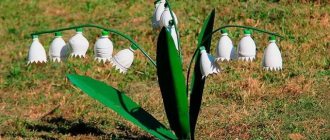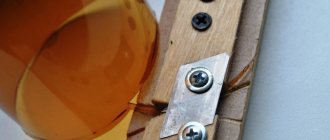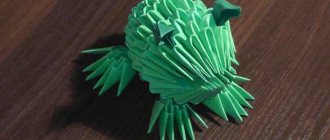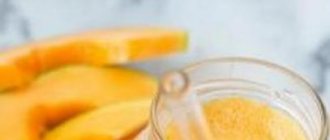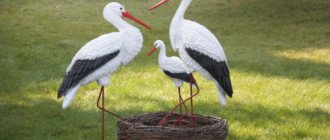Church is a difficult profession. And the point is not only that it may not work the first time, but also in its special internal meaning. Therefore, do not hire him if you do not feel a spiritual mood, and especially if you do not assign such a task to the entire class at school or a group in kindergarten. And when you decide to do this, be patient: it will not be easy, but the result will be excellent and will serve as a table decoration for many years, and will also be a nice gift for Christmas or Easter.
Sequence of gluing a paper church
The “patterns” of all the walls will need to be bent along pre-designated lines, then the walls will be glued to the cardboard area. When all the walls are glued to the site and the glue has dried, you will need to “attach” the domes on top. You can glue them with the same glue that held the walls together. As an option, you can color the cardboard area with colored pencils or paints, or go even further - glue small pebbles and sand to it, and also, for greater realism, make a fence out of matches or toothpicks. Creating an environment is entirely up to your imagination and capabilities. Any paper craft involves a wide range of imagination and creativity.
Conclusion:
Main assembly
When everything is outlined and drawn, the design of the implementation begins. The necessary parts are carefully cut out of whatman paper and glued together in a certain sequence.
We recommend reading:
First, the lower part of the church is built. Along with the extension. Then the superstructure, the upper part, is assembled separately. Once assembled, it is glued to the bottom.
All that remains is to install the dome. The cut off upper part of the plastic bottle is pre-painted golden. Then it is fixed and glued to the top of the structure.
Add an Orthodox cross made of cardboard and painted golden. The necessary details are being completed for a better look of the church.
Required materials and tools
To make a temple out of paper or cardboard with your own hands, you will need the following materials and tools:
- paper cutting board;
- ruler;
- pencil;
- cutter (construction or office);
- glue (PVA, silicone);
- felt-tip pens, paints, markers;
- decorative elements.
Decor options
The finished craft can be revived by decorating it with a variety of decor:
- To create openwork trim, use lace braid.
- Decorate the facade of the building with small paper icons.
- Cover the arches with satin ribbons or decorative colored paper.
- Place wooden figurines of trees and people around the building.
- Paste figurines of doves onto the walls of the building and decorate with gold half-beads and rhinestones.
- A paper dome will look festive if you sprinkle it with gold glitter or cover it with foil.
Ready-made models from paper and cardboard
A paper temple model is made for different purposes. This could be an object for an exhibition of arts and crafts, a competition for children's crafts, or thematic design of a space.
A paper church can look like a Catholic church or a simple village Orthodox building.
A three-dimensional model is made according to exact drawings from thick Whatman paper or thin ornamental cardboard. Very sharp tools are used to cut out parts.
A bright model can be obtained if you assemble a church using the modular origami technique using colored paper.
Wooden church
This option is not suitable for small children and beginners. Even experienced people don’t succeed the first time. But when the craft can be completed safely, it turns out to be a real work of art.
Preparation
You will need a few materials:
- wooden skewers. The required diameter is 3 mm, the material is only birch, never bamboo;
- ice cream sticks or those used to stir coffee;
- matches;
- toothpicks;
- bamboo napkins. Take those where the sticks are the flattest;
- moss.
When making a church out of wood, more than in any other case, good tools are important. You will need:
- sharp knife (construction knife, with the ability to replace blades);
- modified PVA glue;
- needle file
In addition, you will need a photo of the source, preferably more than one and from different angles. Using it, you can calculate in advance the scale of the building in height, length and width.
Step-by-step algorithm:
- Unpack the skewers and inspect them. You should immediately remove crooked, ugly, etc. It will take about a third of the package to throw away. If you do buy bamboo skewers, be prepared to throw away more than half.
- We unravel the bamboo napkins and clean the sticks from any remaining glue and thread.
- In half of the “logs,” notches are made approximately a centimeter from each edge. They are laid in a “well”, so that the notch falls on the edge of the perpendicular “log”.
- Between the first and second logs, lay a floor made from elements of a former bamboo napkin.
- Lay out the walls to the top, gluing each layer. Treat uneven areas with a file.
- Form the top part: place the napkin boards in a “house”. Place logs between them, fasten everything with glue.
- Secure the boards to the roof.
- It is better to have a dome ready. You can make it yourself only on a lathe.
- Decorate the edges of the windows with frames made from the same elements of napkins, matches or toothpicks, three in a row.
- Run two long, narrow strips of wood along the roof ridge to cover the joint.
Your church is ready. Its production is an extremely labor-intensive process that does not always go smoothly. Many things don’t work out the first time and have to be redone. So, before you start this craft, be patient.
If desired, the skewers could be painted with stain before starting the craft - it would be more beautiful and more durable.
It is better to do all the churches yourself, based on photos of layouts on the Internet. So before you start, be sure to look at what result you should get and strive for it.
From plastic bottles
You can make a church with your own hands from anything if you have the desire and the mood. Waste material is also suitable for such a craft - drink bottles, water.
We will “build” on the basis. It must be durable. The ideal option is a shoe box lid. The size of the temple depends on the size of the base - we will select the bottle so that it does not protrude beyond the cardboard lid.
In addition to the base and bottle you need:
- rope and wire;
- thin cardboard and cotton wool;
- white, blue plasticine;
- white paint and brush;
- double-sided tape, PVA glue;
- openwork braid for decoration;
- sharp scissors with long blades.
First you need to prepare the base - paint and build a fence from cardboard “boards”.
Cut off the bottom part and the top with thread from the bottle. We cut the bottom of the workpiece into “noodles” - with its help we will attach the “structure” to the base of the craft. We bend the strips, it looks like a flower.
We bring the “poppy” of the church to the desired shape using plasticine. We make a cross from blue wire and fasten it.
We cover the base of the bottle with double-sided tape, wrap it tightly with white thread, and decorate it with blue lace. We decorate the poppy with cakes made of white and blue plasticine. We place them in a checkerboard pattern.
We cover the “noodles” at the base of the church with double-sided tape and attach it to the base with a fence.
We pave the space between the temple and the fence with cotton wool - these are snowdrifts. With their help, we close the place where the structure is attached and the base of the craft.
You can not limit yourself to one material, but try to combine, for example, wooden skewers and pasta, plastic. Such a church is sure to attract attention and become the leading exhibit at a school exhibition. Imagine, experiment, work with pleasure.
Craft-painting
This version of the craft is simpler than the previous one; you don’t need any tools, just materials and skillful hands.
Preparation
- A3 paper;
- cereals (millet, rice, peas, pearl barley, buckwheat);
- glue;
- gouache;
- some beads;
- gold paint;
- varnish;
- plasticine.
Instructions for making a painting in 7 steps
- Take a piece of paper and draw a church. You can take a photo of the Cathedral of Christ the Savior and redraw it from it.
- Cover the area where the sky is planned with glue and immediately cover it with millet. Let's give it time to dry.
- Also, using glue and cereals, we decorate the details of the picture: we fill the windows with pearl barley and peas, we draw the outlines of the walls and doorways with buckwheat, the clouds will be made of rice.
- We take gouache and paint the sky blue, the windows yellow. Rice on the clouds can be coated with white paint.
- Cover the walls with rice and paint them white.
- We glue beads onto the dome and paint it gold. When dry, coat it with varnish to make it shiny.
- We make flowers from plasticine and make their stems from green threads. Fill the free space on the sheet with flowers.
Our craft is ready. The color scheme proposed here is not a dogma, you are free to choose your own.
What influences the choice of sizes and methods of fastening rafters
A very important point. The task of any fixation is to ensure the stability of the connection node, while it can be stationary or have one or more degrees of freedom. This cannot be achieved without knowledge of the loads affecting the rafter legs. Loads can be permanent and temporary, dynamic and static, unidirectional and multidirectional.
Constant vertical forces. They arise due to the impact of roofing and roof insulation materials. Due to the fact that the rafter legs are located at an angle to the vertical force, they are subject to bending and expansion loads. The magnitude of the forces is determined after constructing the diagram; based on the specific bending and expansion forces, the thickness and width of the boards for the rafters is selected. The fastenings must prevent the rafter system from spreading.
Variable vertical forces. Appear in winter, the magnitude depends on the depth of the snow cover.
Lifting wind forces. As a result of gusts of wind, lifting forces are applied to the roof. The dimensions of the rafter legs are not affected; the forces are taken into account only when choosing the type of fixation; it must provide for and support such loads.
Lateral forces. The value depends on the windage of the roof. As a result of gusts of wind, lateral forces act on the rafter system
They increase bending and tearing loads. This feature also needs to be taken into account during the manufacture and installation of rafter legs.
Loads acting on the load-bearing structure of pitched roofs
There are options for rigid fastenings of roof trusses; for this, metal plates, corners, screws and nails are used.
Options for rigid fastenings of roof trusses
Sometimes it is necessary to use floating rafter connections to compensate for changes in the size of wooden houses. For floating connections, special fasteners and bolts are used. The second allows the rafter legs at the top to rotate slightly.
Floating connection
Another example of a loose rafter connection is a sliding one. It is used on wooden log houses and makes it possible to compensate for the natural shrinkage of the house.
"Apple"
Craft product modeling design Russian stove corrugated cardboard
There should be a small ball on the dome at the place where the cross is attached - it is called an “apple”.
I made them like this. At a craft store I bought a special mold with semicircular recesses (this mold is intended for quivering):
To make half a ball, I filled the mold with pieces of toilet paper and PVA glue. Each part must dry for 1 day. Then I glued these balloon halves onto the cross on both sides.
However, then I realized that I could have done without it! You need to screw thin strips of toilet paper and cotton wool onto the base of the cross, lubricating them with PVA glue. It was in this way that I later made the “apple” on the mini-domes.
Wonderful crafts
There are exclusive crafts made from matches church. Good work like this takes months to complete. A lot of matches are wasted. But it turns out to be a surprisingly beautiful thing.
Some people are so keen on building from matches that, starting with simple houses, they get to creating not just a church, but a temple from matches. It turns out to be an amazing work of art.
We recommend reading:
This craft is based on the method of folding matches into squares. Using glue. The work is painstaking. You need sensitive hands and attentiveness. There are established standards when creating such forms.
But craftsmen who have learned to work according to standard schemes go further. They are inventing new ways to build turrets and domes of churches and temples from matches.
Construction of a Papercrete dome from paper, and also from steel and cement
When my friend Wendy Tremaine and I arrived in southern New Mexico, one of the first things we did was look at local building materials. Clay had to be dug up and hauled away, straw bales were already expensive and not local, ready-made building materials were too expensive for us. We ended up figuring out what we had locally, and it was paper.
5. Your rocket needs wings. They need to be cut and glued.
6. Glue all the wings to the rocket.
Origami rocket
This rocket model is very beautiful, and you simply must make it with your children.
Assembling such a rocket is not difficult, just do everything as shown in the video tutorial.
The assembly itself should take no more than 15 minutes.





